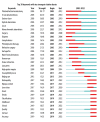Exploring the Research Landscape of High Myopia: Trends, Contributors, and Key Areas of Focus
- PMID: 38111192
- PMCID: PMC10748438
- DOI: 10.12659/MSM.941670
Exploring the Research Landscape of High Myopia: Trends, Contributors, and Key Areas of Focus
Abstract
BACKGROUND Myopia results when light rays focus before reaching the retina, causing blurred vision. High myopia (HM), defined by a refractive error of ≤-6 diopters (D) or an axial length of ≥26 mm, is an extreme form of this condition. The progression from HM to pathological myopia (PM) is marked by extensive ocular axis elongation. The rise in myopia has escalated concerns for HM due to its potential progression to pathological myopia. The covert progression of HM calls for thorough analysis of its current research landscape. MATERIAL AND METHODS HM-related publications from 2003-2022 were retrieved from the Web of Science database. Using VOSviewer and Citespace software, we conducted a bibliometric and visualized analysis to create document co-citation network maps. These maps detailed authors, institutions, countries, key terms, and significant literature. RESULTS From 9,079 articles, 8,241 were reviewed. An increasing trend in publications was observed, with Kyoko Ohno-Matsui identified as a top contributor. The Journal of Cataract and Refractive Surgery was the primary publication outlet. Chinese researchers and institutions were notably active. The document citation network identified five focal areas: refractive surgery, clinical manifestations/treatment, prevention/control, genetics, and open angle glaucoma. CONCLUSIONS Research emphasis in HM has shifted from refractive surgery for visual acuity enhancement to the diagnosis, classification, prevention, and control of HM complications. Proposals for early myopia intervention to prevent HM are gaining attention. Genetics and HM's link with open angle glaucoma, though smaller in focus, significantly enhance our understanding of HM.
Conflict of interest statement
Figures








Similar articles
-
Rate of progression of total, upper, and lower visual field defects in patients with open-angle glaucoma and high myopia.Jpn J Ophthalmol. 2016 Mar;60(2):78-85. doi: 10.1007/s10384-016-0427-3. Epub 2016 Jan 29. Jpn J Ophthalmol. 2016. PMID: 26822678
-
Global Tendency and Frontiers of Research on Myopia From 1900 to 2020: A Bibliometrics Analysis.Front Public Health. 2022 Mar 10;10:846601. doi: 10.3389/fpubh.2022.846601. eCollection 2022. Front Public Health. 2022. PMID: 35359777 Free PMC article.
-
Trends in research related to high myopia from 2010 to 2019: a bibliometric and knowledge mapping analysis.Int J Ophthalmol. 2021 Apr 18;14(4):589-599. doi: 10.18240/ijo.2021.04.17. eCollection 2021. Int J Ophthalmol. 2021. PMID: 33875953 Free PMC article.
-
Progress in understanding the association between high myopia and primary open-angle glaucoma.Clin Exp Ophthalmol. 2014 Mar;42(2):190-7. doi: 10.1111/ceo.12158. Epub 2013 Aug 4. Clin Exp Ophthalmol. 2014. PMID: 23845009 Review.
-
The Complications of Myopia: A Review and Meta-Analysis.Invest Ophthalmol Vis Sci. 2020 Apr 9;61(4):49. doi: 10.1167/iovs.61.4.49. Invest Ophthalmol Vis Sci. 2020. PMID: 32347918 Free PMC article.
Cited by
-
Study on the impact of children's myopia on parental anxiety levels and its related factors.Eur J Pediatr. 2024 Dec 20;184(1):94. doi: 10.1007/s00431-024-05938-0. Eur J Pediatr. 2024. PMID: 39707023 Free PMC article.
-
Association of outdoor artificial light at night with myopia among Chinese adolescents: a representative cross-sectional study.Front Med (Lausanne). 2024 Sep 27;11:1469422. doi: 10.3389/fmed.2024.1469422. eCollection 2024. Front Med (Lausanne). 2024. PMID: 39399108 Free PMC article.
References
MeSH terms
LinkOut - more resources
Full Text Sources
Medical

